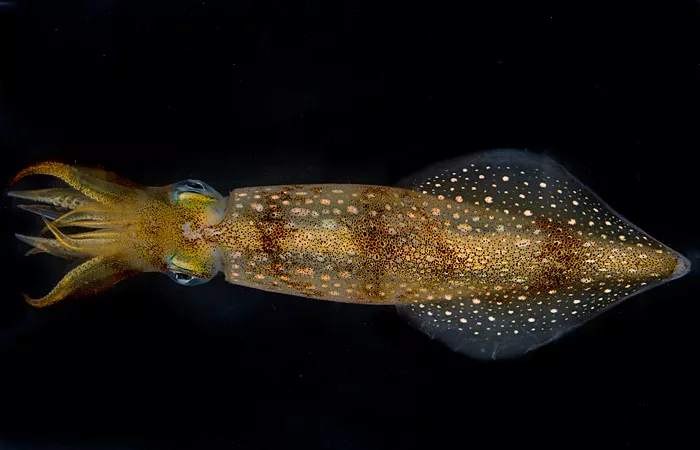Squid can detect sounds, but is it hearing?
Despite their central importance in the marine food web, it is amazing how little we know about how squid find their way in the watery world—what senses they rely on to navigate, avoid danger, find food, and perhaps communicate with each other.
n a hangar-like research building at the Woods Hole Oceanographic Institution (WHOI), biologist T. Aran Mooney is exploring virtually uncharted waters: Can squid hear? Is their hearing sensitive enough to hear approaching predators? How do squid and other marine species rely on sound to interact, migrate, and communicate? Will the burgeoning cacophony of sound in the ocean disrupt marine life's behavior and threaten their survival?
Finding this out isn’t exactly trivial; it’s not as if you can just play a tone and see if a squid raises a tentacle in response. Mooney and colleagues had to develop novel experimental techniques to learn if, and what, squid can hear. In a study published Oct. 15, 2010, in The Journal of Experimental Biology, they confirmed that squid can indeed detect sound. Now, they have begun to investigate a relatively rudimentary sensory organ in squid to see what it can tell us about the evolution of hearing in higher animals.
A primitive ‘ear’?
In the well-studied ears of humans, sound waves strike the eardrum and set it vibrating. An array of tiny bones in the middle ear amplifies the vibrations and sends them rippling through fluid in a spiraling tube called the cochlea. The cochlea is lined with hair cells. On one end, they have hair-like structures that project into the fluid in the cochlea; on the other end, the cells connect with nerve fibers outside of the cochlea. The vibrations generate movement of the fluid, which bends the hairs and triggers nerve impulses transmitted to the brain.
Squid have two organs called statocysts, which have intriguing similarities with cochleas. Located near the base of the brain, each statocyst is a hollow, fluid-filled sac lined with hair cells. On the outside of the sac, the hair cells are connected to nerves, which lead to the brain.
“It’s kind of like an inside-out tennis ball,” Mooney said, “hairy on the inside, smooth on the outside.”
Inside each sac is a tiny grain of calcium carbonate called a statolith. The statolith enables the squid to sense its position in the water. Normally it rests near the front of the sac, touching some of the hair cells. But when a squid moves quickly—as it does when it flees an approaching predator—the heavy calcium stone lags behind slightly before catching up to the hair cells.
Can you hear it now?
Mooney and colleagues used a technique similar to hearing tests routinely conducted on newborns, who, like squid, can’t readily affirm that they’ve heard something. In those tests, electrodes are placed on the infants’ heads, and sounds are presented to them through earphones. The sounds stimulate electrical activity in nerves that is recorded by the electrodes.
Similarly, Mooney wanted to test whether the nerves coming from squid statocysts send impulses in response to sound. To do that, he had to attach an electrode just under the squid’s skin near the nerves that extend from the statocysts. To do that, he had to anesthetize the squid.
Low frequencies
His preliminary findings showed that squid statocysts respond to sounds, but only to relatively low frequencies, up to 500 Hertz; they do not detect the very high frequency echolocation sounds that dolphins use to find prey. The squid auditory range is similar to a lot of fish, suggesting they both responded to similar evolutionary pressures. (Human hearing spans a range from about 20 Hz to 20,000 Hz.)
Mooney said his work falls under the heading of “sensory biology,” the study of how animals use their sensory systems to figure out the world around them. He thinks squid statocysts have a lot to teach us about how ears originated and evolved.


























